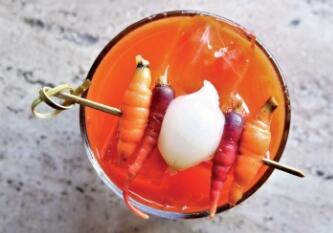
Vegetables aren’t totally new to cocktails. Tomato juice—though technically from a fruit—is a key ingredient of bloody marys, while greens like celery have traditionally served as a garnish. Beyond this brunch staple, however, today’s restaurants and bars are using an array of vegetables as major ingredients in alcoholic creations.
“It’s the perception of healthiness,” says Mike Ryan, director of bars for Kimpton Hotels & Restaurants. “Guests feel it’s a way to get their antioxidants. It also tastes good.”
The trend of fresh, local ingredients also plays a role, says Yoranis Garcia, senior service manager of Terra Mare in Fort Lauderdale, Florida. “Our fruit and vegetables are local if we can get them. It’s all about bringing freshness to our restaurant.”
And then there’s the flavor. “I really like that savory aspect vegetables bring,” says Jeff Williams, executive chef of Chicago’s The Press Room. “It adds a layer of complexity to the cocktail.”
All of these trends combine with the growing popularity of cocktails, Williams adds. “The next cool thing is using new or atypical ingredients you don’t use every day.” Plus, it gives bartenders a chance to come up with some great names.
The Northman cocktail at The Press Room features blanched arugula cooked in a simple syrup. The mixture is pureed, strained, and combined with pear brandy, aquavite, and lemon. And a new leek-infused vodka cocktail, Every Morrissey Song, “is the most interesting thing I’ve seen,” Williams says. Roasting the leeks eliminates the onion notes leaving an earthy vegetable flavor. It’s added to Lillet Blanc, creme de cassis, and lemon. Another cocktail at The Press Room uses cucumber-infused tequila.
The Green Tox cocktail at Honey Salt in Las Vegas plays on combining a tox and a detox—alcohol and green goodness juice—in a cocktail. It’s based on the idea of a bloody mary, but with sweetness rather than spiciness, says Elizabeth Blau, founder and CEO of Blau + Associates, which operates this and nine other restaurants. “The Green Goodness Juice is super popular in the restaurant and has lots of vegetables, vitamins, and nutrients,” she says. It’s made with apples and vegetables including kale, celery, cucumbers, spinach, “and whatever comes in fresh.” The juice is blended with vodka and lemon juice, like a bloody mary, then agave nectar is added. “It’s so green,” Blau says. “People see it on other tables and ask for it.”
Numerous vegetables dot Kimpton’s cocktail menus, including carrots, beets, cucumbers, radishes, kale, and celery. Not all vegetables can work—like the jicama, for instance, Ryan says—but many do and, often, better than expected.
The Mellow Yellow cocktail at Henley in Nashville, Tennessee features yellow bell peppers, tequila, agave, lemon, salt, and Mantra Saffron IPA, a local brew. “The response has been phenomenal,” Ryan says. “It hits all the right notes.”
Firefly in Washington, D.C. features a That’s How We Cass-E-Role cocktail with puréed green beans, cynar liqueur, mezcal, green Chartreuse, and salted lime simple syrup, and an Aw, Snap! cocktail with gin, Cointreau, and a syrup with snap peas and herbs sourced from its rooftop garden. “People want an experience,” Ryan says, especially if they spend $12 to $18 for a drink.
Terra Mare extends its farm-to-table ethos by making its own cold-pressed juices. This is time-consuming, but “the flavor is worth it,” Garcia says. “You are getting a product that is a concentrated form of the juices.” And it retains more of the nutrients, which makes sense for guests “who would rather drink their vegetables than eat them,” she says.
The juice of root vegetables is part of two popular, earthy cocktails at Terra Mare. Jessica Rabbit combines carrot, orange, and lime juices, jalapeño pepper slices, silver tequila, and Cointreau, while the Beet It cocktail has beet, pear, and apple juices, vodka, egg white, and house ginger syrup.
The idea of combining cold-pressed juices with spirits to create feel-good cocktails resulted in a collaboration between two Louisville, Kentucky entities: Rabbit Hole Distilling, which makes bourbon and rye whiskey, and The Weekly Juicery, a juice bar with five locations in Kentucky and Ohio.
“I was thinking that cold-press juices are doing very well and taste fantastic,” says Michael Motamedi, Rabbit Hole’s chief marketing officer. The companies developed several cocktail recipes for their customers. The Green Rush cocktail combines bourbon and two juices, Green Lemonade with romaine, cucumber, and kale among its ingredients and Cucumber Crush with cucumber and orange. The B&B has bourbon and Orange You Happy juice with orange, romaine, green apple, ginger, lemon, lime, and beets.
“This is a movement we want to start and hope catches on,” Motamedi says.







